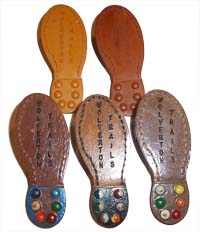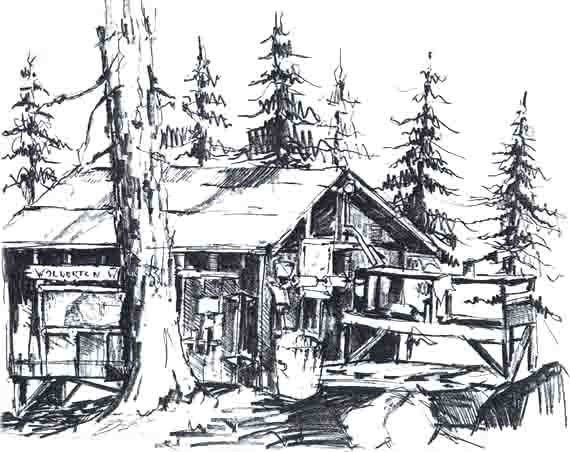continued
CLICK ON ANY IMAGE BELOW TO ENLARGE IT
The Wolverton Sequoia Tree
A fairly large sequoia tree exists in the center of camp near the old parade ground. Nobody is sure who planted it or when. In the early 1960’s, it was reportedly only six feet tall. Perhaps it was transplanted as a seedling a few feet tall in the late 1950’s. Cliff Putnam was a camper at Wolverton in 1952 and 1953, and he was on staff from 1954 through 1957 – when interviewed at Camp in 2008, he did not remember that tree being in Camp. Neither did Gale Williams remember the tree, Cliff’s friend and fellow Scout camper in 1952 and 1953. Some people have said it is a seedling from the General Sherman tree, but that has not been verified. Perhaps tree DNA analysis is needed. It appears to be very healthy and about 80 to 100 feet tall. It was named the “Wolverton Tree” by Scott Robbins in the early 1980’s. The Wolverton tree was watered several times each summer by Art Marquez and others from the 1960’s through the 1990’s (that’s an inclusive period of forty years!).
In the mid 1980’s, five additional sequoia seedlings were purchased from the Giant Forest gift shop and planted around the main camp area by Mike Smith, Lisa Bishop-Smith and Art Marquez. An inspection of the camp in July 1999 revealed that only two of the five were remaining. In July 1999, they were healthy and about three feet tall. In July 2008, those two sequoia trees were still alive and healthy, and about five to six feet tall. They are twenty years old now; any year now they are going to take off and really grow up.
 |
Wolverton Trails Hiking Boot
Neckerchief Slide |
During the 1960’s and 1970’s, campers at Wolverton could purchase a Wolverton Trails hiking boot neckerchief slide at the Camp trading post for about 35 cents. At the end of the week, in the Handicraft area, the Scouts would paint the slide to show the locations they went while backpacking in the backcountry with their troop. Each color on the nail of the boot heal represented a specific location such as Pear Lake or J.O. Pass in the backcountry. Campers (and Staff) who had been on several Wolverton backcountry trips would end up splitting the boot nails into multiple colors. Scouts throughout the Crescent Bay Area Council recognized these neckerchief slides and knew the hiking accomplishments they represented. Shown in the photograph above are two unpainted plastic slides (light color and dark color) as they were delivered by the Neal Slide Company and sold at the Wolverton Trading Post, and three examples of painted slides.
Latrines
Camp Wolverton has always had pit toilets, sometimes called “kybo’s,” but no flushies. Some of the latrines were single seaters for privacy, and some were double seaters for good conversation, such as the one on Staff Hill. Some had roofs to keep the rain and snow out, but many people preferred the ones without roofs; they let in all the sunshine.
It was a good thing the kybo below the Lodge didn’t have a roof in 1972. Just ask staff man Doug Soloman. About five minutes after Doug entered the kybo, a big black bear entered it too. Doug’s choice of escape was limited to up or down. Because there was no roof, he chose up. With his scout shorts still around his boots, he popped out of that kybo like a jack in the box.
The camp prides itself with having the sweetest kybo’s west of the Mississippi. They have always been kept clean, sanitized, and well-stocked with tickets. A little trick to prevent the kybo from smelling has always been to keep a bucket of ashes (charcoal) in each kybo; just pour a spoonful into the pit after each use. Rich Stowell started this tradition during the late 1970’s. He says he remembered reading about it in a novel and it seemed like a good idea.
Click on this link for more information on camp latrines.
Hikes from Wolverton
Backpacking from Camp Wolverton has always been a favorite. Probably the most respected hike is the Wolverton to Whitney trip. Some of the more popular hikes during the last 35 years have been the Silver Bearpaw, Silver Cloud, and Wolverton to Whitsett.
During the winter of 1965-66, Wolverton staffmen Arnie Sillman and Mike Robbins met with Paul Turner, the Kaweah District Ranger at his home on the hill above the coffee shop in Giant Forest Village. After some brainstorming, they came up with routes for two loop trips, beginning and ending at Camp Wolverton, and completely shown on the Triple Divide Peak quadrangle map. Click on this link to see more about these hikes.
During the summer of 1966, a group of Wolverton staffmen hiked what was to become known as the Silver Bearpaw Trail and reported on its conditions. The first group of Scouts hiked the 61-mile trail during the summer of 1967, and received an award patch (see the Memorabilia Section) for completing the hike. The route begins at Camp Wolverton, drops down to Lodgepole, and climbs to Twin Lakes and Silliman Pass. It then drops down to Ranger Lake, crosses the Sugar Loaf Valley and goes on to the Roaring River Ranger Station. From there, it goes up Deadman’s Canyon to Elizabeth Pass with an optional side-trip to Big Bird Lake. From the pass it drops down to Bearpaw Meadow and then follows the High Sierra Trail to either the Panther Gap Trail or into Giant Forest and then back to Camp Wolverton.
The 45.5-mile Silver Cloud Trail is a shorter (although more challenging) loop partially within the loop covered by the Silver Bearpaw and including a trek up Cloud Canyon and over Copper Mine Pass. An award patch became available for the Silver Cloud trail beginning in 1972 (see the Memorabilia Section).
The trips were promoted and directed by the Wolverton Staff until they were adopted by the Boy Scout’s High Adventure Team. These trips are still listed as active award hikes today. During the late 1960’s and early to mid 1970’s, the staff of Wolverton frequently hiked the Silver Bearpaw at the beginning of each summer to get in shape and reacquaint themselves with the backcountry.
Also, there were the KFI (Los Angeles) radio station High Sierra hikes. Some people have suggested that these hikes had something to do with Wolverton. Unfortunately, they did not. A review of all of the KFI trip records show that the KFI groups never stayed at Camp Wolverton.
Polaris Training
Polaris Training was a 1960’s to 1970’s Scout leadership training program developed for the Crescent Bay Area Council. The first part of the program was called Polaris One Star. It was a weekend-long training held at Camp Josepho in the Santa Monica Mountains. If a Scout passed this part of the program, he could attend Polaris Two Star training at Camp Wolverton (in 1967 at a cost of about $50 for the week - at the same time a week of regular camp ran about $35) for a week in the summer at Camp Wolverton. Between the Scouts attending the program and the program’s own staff, there could be up to 200 people in Camp. Scouts would stay in the three main camping area of Camp Wolverton: Bear Haven (across Wolverton Creek), The Meadows (across Wolverton Road), and Deer Hollow (in the area west of the Lodge).
Next, the Scouts who completed Polaris Two Star could become junior staff at the next year’s One Star, back at Josepho. They could also attend another one-week course called Polaris Three Star which was not held at Wolverton. Then, those Scouts could return to Wolverton the following summer to be on the junior staff of Two Star. And so it went.
Dan’l Silpa has a story from his days as assistant cook in the early 1970’s when the Polaris crew was in camp. “One year, we could not afford to keep the professional chef for the week of Polaris training. Thus, after a few weeks as assistant cook, it fell to me to be the chef.
“Polaris had their own time schedule. One night, their schedule planned dinner to be at 4:30 p.m. instead of the usual 6:00 or 6:30. Everybody knew about this schedule change...except me.
“It was barbecue chicken night. I was cooking for about 120 people.
“Well, the chicken wasn’t quite cooked enough! Only one leader brought his meal back to me to exchange for a more well-done piece. Nobody was reported to come down ill the next day!
“Today I know all about Salmonella gastroenteritis. If divine providence and blind luck were not looking after the Camp and me that night, I might have killed off a few Scouts and swamped the Central California hospitals with a hundred cases of food poisoning!”


